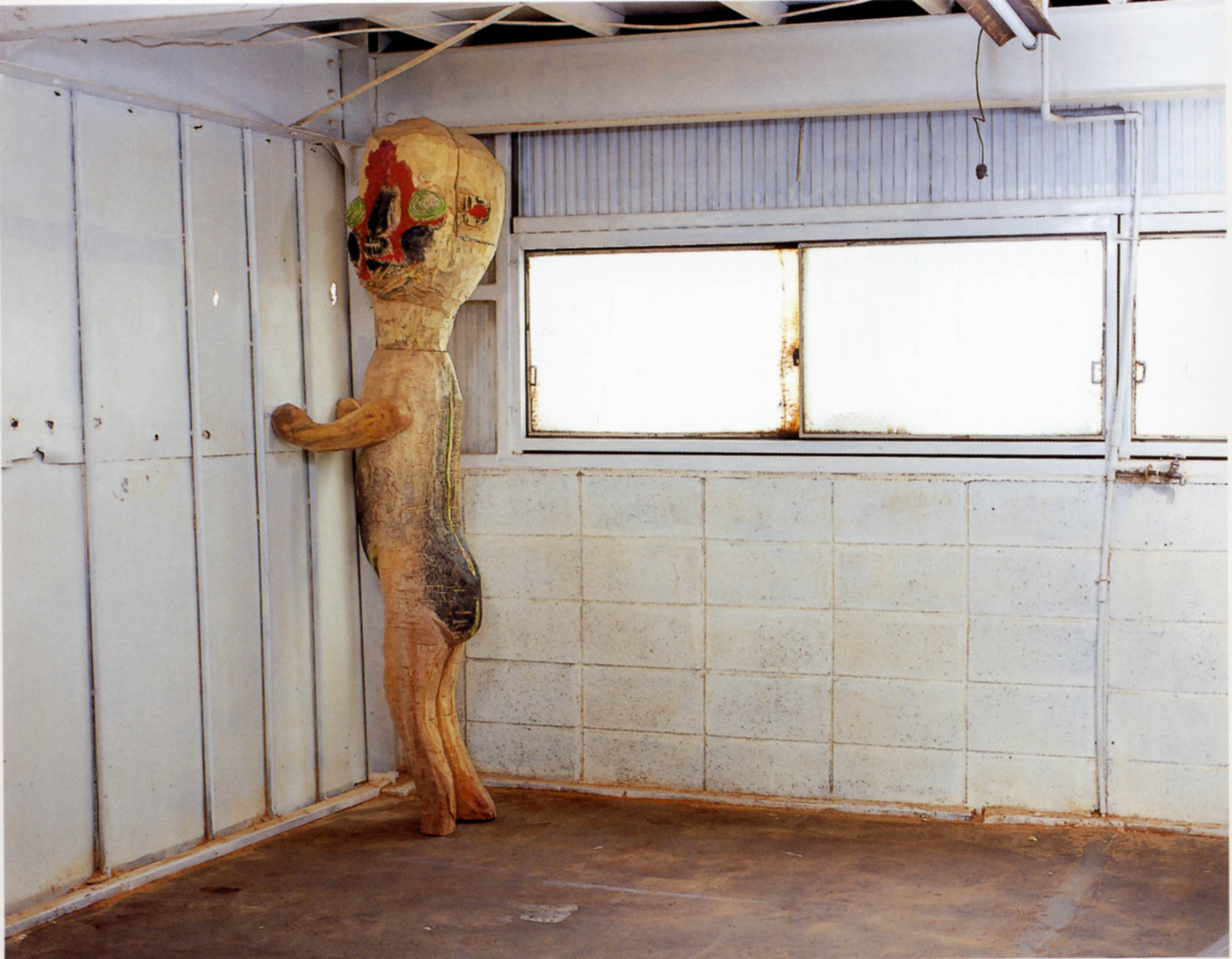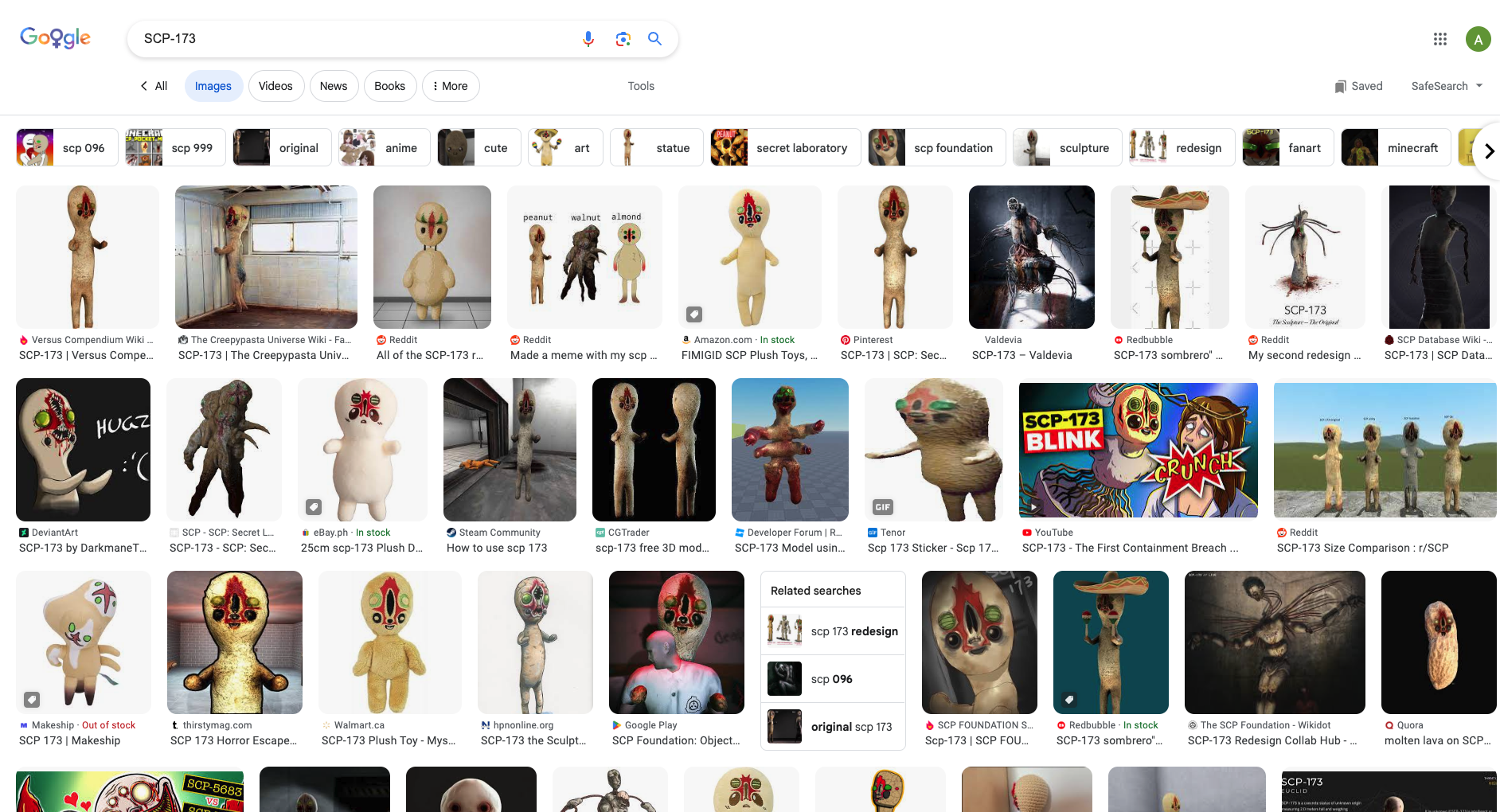Izumi Kato’s Virtual Shadow
By Alex Yiu

IZUMI KATO, Untitled, 2004, wood, charcoal, acrylic, 205 × 56 × 52 cm. Photo by Keisuke Yamamoto. Courtesy the artist and SCAI The Bathhouse.
*Updated on Mar 22, 2024.
Call them repugnant, call them uncanny, but Japanese artist Izumi Kato’s eerie depictions of fetuses in sculptures and paintings ushered in a new era of contemporary art. His works are familiar to institutions and auction houses—they have been exhibited globally and are sold at premium prices—yet, their subjects fortuitously gave rise another contemporary phenomenon: SCP-173, a paranormal “concrete sculpture” circulated by the SCP Foundation, a (fictional) secret organization whose website is favored by the chronically-online. While this latter craze speaks to Kato’s resonance and popularity, upon closer examination, it also clarifies what sets his practice apart from other iconic Japanese pop artists.
The viral phenomenon began on June 22, 2007, when the anonymous netizen moto42 posted a short story about SCP-173, titled “The Sculpture,” in the “/x/ - Paranormal” forum of 4chan, an online site for threaded discussions. The story revolves around a secret institution, the “Special Containment Procedures” (SCP) Foundation, that researches supernatural phenomena and “anomalies” in a confined environment, unbeknownst to the public. The story alleged the Foundation hosts a hostile animate sculpture, numbered 173, that snaps victims’ necks and strangulates them if they do not maintain eye contact with it. Accompanied by a photograph of Kato’s real-life sculpture, Untitled (2004), the online fan-fiction went viral, inspiring thousands to contribute other entities and stories. This ultimately led to the establishment of an eponymous collaborative online platform, with Kato’s Untitled as its face.

Google Image Results of SCP-173 on Mar 8, 2024. The second result is the actual artwork Untitled, 2004 by IZUMI KATO.
The artist was later informed what transpired. He chose to allow the use of his artwork for noncommercial purposes, but that did not stop derivative works of SCP-173 from emerging. In fact, illustrations, plush toys, videos, fan-made video games, and other iterations flooded the internet without Kato’s approval for more than 15 years. That all ground to a halt when, remarkably, under no obligation to or request from the artist himself, in 2022 the SCP Foundation announced that it would take down the image of Untitled to respect Kato’s artistic vision and his work. The artist did not comment on the removal. Actually, aside from the permission he once reluctantly granted, he never issued any public statements regarding the SCP Foundation. Even on social media, Kato evaded the discussion, opting instead to post about his art, fishing expeditions, and music collections.
While Kato’s laissez-faire attitude may seem perplexing, it parallels his artistic approach. Indeed, despite his work being a modern sensation, compared to other eminent Japanese pop artists such as Takashi Murakami, known for his collaboration with musical artist Kanye West, or Yayoi Kusama’s polka-dotted pumpkins and Louis Vuitton handbags, Kato does not identify his art with popular culture. Murakami and Kusama arguably rely on mass media and consumerism, but Kato has mentioned that he does not prioritize making artwork for market demands. Rather, his work recalls an aspect of Japanese art that is more conceptual and shadowy—yugen, a Japanese aesthetic concept that describes a feeling of veiled unspeakableness and a sensation of deep mysticism.

IZUMI KATO, Untitled, 2023, (left) acrylic on wood, plastic model, stainless steel, 67 × 46 × 20 cm, (right) fabric, acrylic, pastel, collage, embroidery, 40 × 48 cm. Courtesy the artist and Perrotin.
Such qualities are common in Japanese artistic traditions and evident in literature. The author Junichiro Tanizaki expanded upon the aesthetic in his 1933 essay “In Praise of Shadows,” observing yugen ’s presence in everything from Japanese architecture to day-to-day living. Per Tanizaki’s analysis, since the Meiji Restoration kickstarted modernization in the mid-19th century, Japanese artists have produced work that resists infiltrating Western influence. Likewise, many of Kato’s sculptural works made of wood and stone resemble the earthy rustiness found in prehistoric Japanese artifacts from the Jomon to Yayoi period. These elements also reflect the influence of Kato’s rural upbringing, as well as a concept in the Shinto religion, Yaoyorozu no Kami, which refers to the countless gods, goddesses, and spirits in Shintoism. Kato’s allusions to ancient Japanese iconography, aesthetics, and religion make his oeuvre quintessentially “Japanese” in that it follows a canonical regional movement, wherein art reacted to over-modernization and capitalism in Japanese society.
Interestingly, although Kato’s works are immensely popular among collectors, the artist’s impact on internet culture remains rather obscure, and many netizens are unaware of how Untitled became appropriated by SCP-173. In ignoring this viral iteration, however, collectors and netizens alike miss what makes Kato’s work so resonant. Unlike the dominant colors and ebullient compositions of Murakami and Kusama, whose iconic works are celebrated by the public, Kato’s mysterious and shadowy sculpture, Untitled, allowed others to transmit their own creativity through numerous derivative works. While Kato’s intention may have been to evoke yugen aesthetics, the shadow and mystery in his sculpture were also able to capture the ever-sidetracked attention of the internet, providing an opportunity for others to explore and express their own imagination.
As the impact of contemporary art has been reduced within institutionalism and through elitist consumerism, perhaps then the phenomenon surrounding Kato’s Untitled can serve as inspiration for emerging pop artists, who wish to subvert the norm. As the virality of “The Sculpture” demonstrates, contemporary art can go beyond being a part of a collection, being displayed by an institution, or being exclusively appreciated by the cultural elite.

Installation view of "Izumi Kato", 2023, at Perrotin Paris. Photo by Claire Dorn. Courtesy the artist and Perrotin.
A solo exhibition of Izumi Kato at Perrotin Hong Kong will open on March 24, 2024.
Alex Yiu is associate editor at ArtAsiaPacific.







